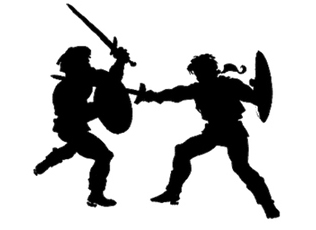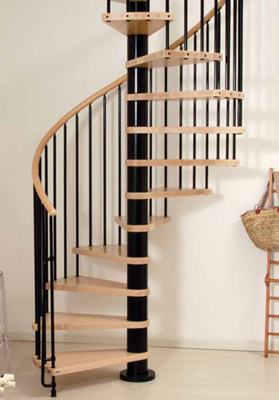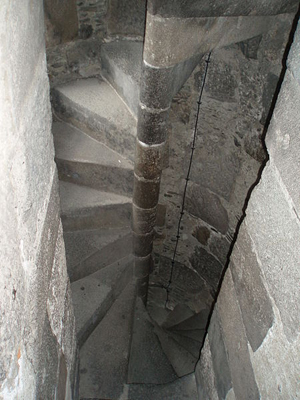
The Swordsman and the Spiral Staircase … sounds like a Grimm Fairy Tale, right?
Thanks to my good friend Wikipedia, I recently learned a swashbuckling fun-fact about the history of spiral stairs. Way back in medieval times, spiral staircases were generally made of stone and they typically wound in a clockwise direction (from the ascender’s point of view). This clockwise direction placed attacking swordsmen, who were usually right-handed, at a tactical disadvantage to the defenders of the castle who would confront them on the stairs with blades of their own. As Wikipedia explains: “This asymmetry forces the right-handed swordsman to engage the central pike and degrade his mobility compared with the defender who is facing down the stairs.”
By positioning the center post as an obstacle for the attackers, spiral stairs served as a clever means of defense from the hordes of orcs and trolls that would raid your castle back then—all the more reason to put spiral stairs in your home today. Examples of these stairways can be seen at Muchalls Castle, Crathes Castle and Myres Castle in Scotland.
These days, you can bypass medieval stone construction and equip your castle with a spiral staircase in kit form. Steps and handrails can be bolted together to form a complete unit, and modular kits can be assembled on site. These stairs can be made out of steel, timber, concrete or a combination of materials.
Our friends at Arke Stairs offer spiral and modular staircase kits that can be built in a day by the average DIY home enthusiast.
Buying and installing is easy with the Arke’s specialty features:
- All-in-one complete units
- Treads, landing, balusters, handrails, hardware and accessories included
- Nothing to paint, weld, stain or seal
- In stock for immediate delivery

Check out Arke Stairs online at www.arkestairs.com.
— M. Weber





